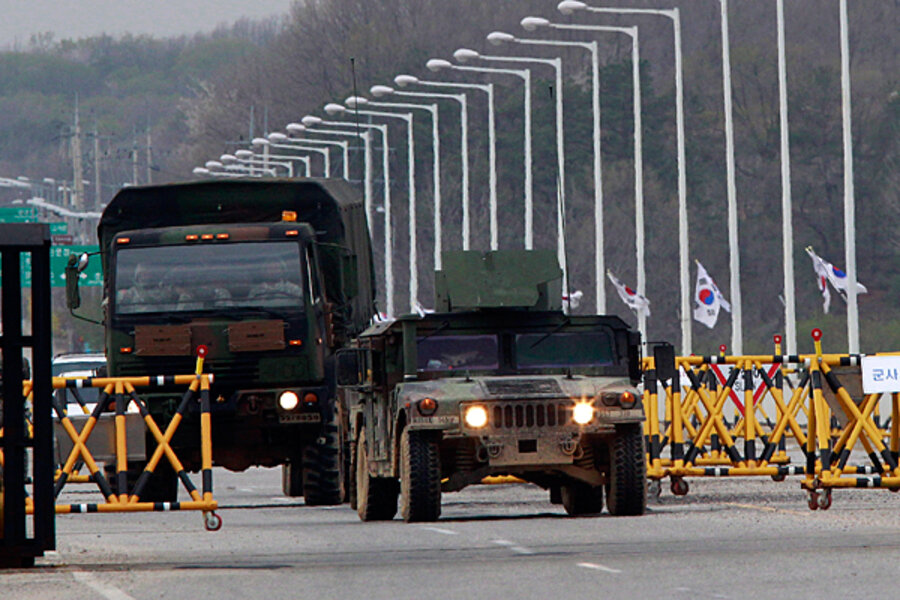As South Korea and US end military drills, how will North Korea react?
Loading...
The US-South Korea annual military exercises ended without incident on Tuesday, perhaps allowing a chance for weeks of tensions on the Korean peninsula to enter an indefinite period of calm.
The annual military defensive exercises are intended to act as a deterrent to North Korea through shows of military prowess. North Korea, however, called the two month-long exercises an aggressive invasion threat and promised military retaliation if provoked directly.
But now that the exercises are over, the North could tell its people that its own military successfully warded off the threat, conceivably allowing it enter dialogue with the South without appearing to lose face. But some analysts argue that as the general atmosphere has cooled, action by North Korea could actually be more likely.
“Now that the exercises are over, this is an opportune time for a missile launch,” says Sung-yoon Lee, professor at the Fletcher School of Law and Diplomacy, Tufts University. “Now that their adversaries have their guard down, they could go ahead with a launch now, ahead of the upcoming summit between Obama and Park Geun-hye, to put pressure on Park.”
South Korean President Park Geun-hye, who was inaugurated on Feb. 25, is scheduled to meet with US President Obama in Washington on May 7. North Korea has been known to purposely raise tensions in an effort to rattle new administrations in Seoul or Washington.
"The drill is over, but the South Korean and US militaries will continue to watch out for potential provocations by the North, including a missile launch," said Kim Min-seok, a spokesperson for South Korea’s Ministry of National Defense.
The two-month long exercises started up shortly after the North's third nuclear test in February and involved around 10,000 US troops and 200,000 South Korean forces. Throughout the exercises, some impressive weaponry was shown off, including B-52 bombers and a nuclear-armed submarine. After the exercises began, the North announced it was scrapping an armistice agreement that effectively put the Korean War on hold, and said it was entering a "state of war." The North also cut two hotlines to South Korea, symbols of North-South cooperation, but left a joint economic region alone until April.
The jointly-operated Kaesong industrial park, the last major symbol of cooperation between South and North was designed to economically benefit both sides, providing South Korean companies with cheap labor, and North Koreans with much needed income. Since it was started in 2004, it has survived years of chilly inter-Korean relations.
But North Korea unexpectedly barred South Koreans from entering the area early in April and then withdrew all its workers shortly thereafter. Though some South Korean workers stayed at the complex, many went back to South Korea.
The situation at Kaesong is one aspect of the crisis that appears set to continue.
Yesterday, 43 of the final 50 South Korean workers in Kaesong returned home. Seven stayed behind to deal with some unpaid wages, as North Korea has not approved their departure yet, according to Chosun. There is not yet any indication that Seoul and Pyongyang will cooperate in finding a way to get operations at the complex back underway. The complex brought in about $80 million in revenue for North Korea in 2012, so there is a large financial incentive for the North to restart business there.
Today South Korean Minister of Unification Ryoo Kihl-jae said that while the South is interested in restarting operations at Kaesong, Seoul wouldn’t accept just any conditions demanded by North Korea.
"It is pointless to normalize operations at the Kaesong Industrial Complex if it entails accepting unreasonable claims and preconditions," Minister Ryoo said.
All throughout the war games, many analysts speculated that North Korea’s intention was to stir tensions and pull back at the last minute from any kind of engagement in an effort to strengthen its bargaining position when it returns to the table at some later date.
“The general principle is to escalate tensions in order to later be able to negotiate from a position of strength,” Leonid Petrov, a researcher in Korean studies at Australian National University, told the Monitor on Apr. 10.






